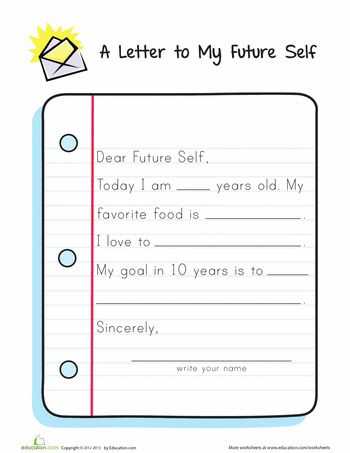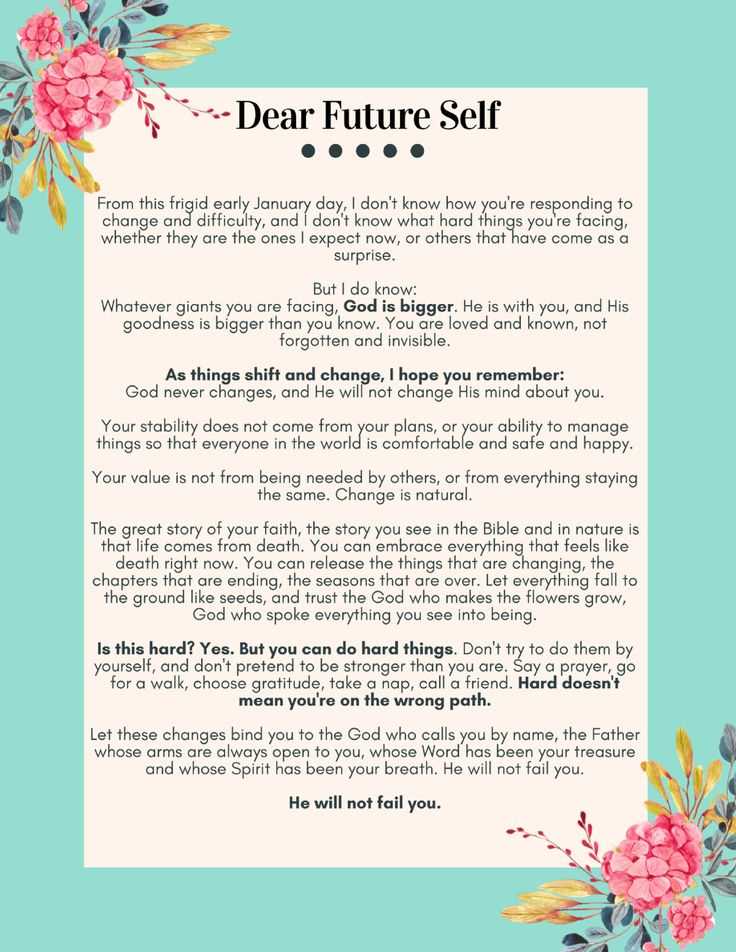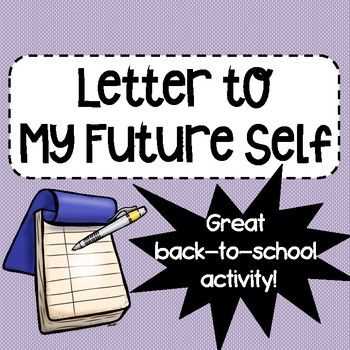How to Write a Letter to Your Future Self with This Template

Looking ahead and reflecting on your journey can be an inspiring exercise. Writing a personal message to the person you’ll become helps you clarify goals, thoughts, and hopes for the years to come. It’s a powerful way to connect your present actions with your future aspirations.
Creating a message that will be read later can give you the opportunity to reflect on where you are today and where you want to go. It’s a tool that encourages mindfulness, self-reflection, and intentional growth. Whether you’re thinking about personal milestones, achievements, or challenges, writing can help you put your thoughts into perspective.
By following a simple structure, you can easily craft a meaningful note that will resonate with you in the future. This process doesn’t need to be complicated – it’s all about being honest, thoughtful, and focused on what truly matters to you. By committing your ideas to paper (or digital format), you create a powerful connection between where you are now and who you hope to become.
Why Is This Exercise Important?
Looking ahead and reflecting on your personal journey can be a meaningful and rewarding practice. By engaging in this activity, you create a bridge between who you are today and the person you aim to become. It allows you to pause, take stock of your life, and envision your path forward.
Here are a few reasons why this practice can be so valuable:
- Clarifies your goals: Writing down your thoughts forces you to articulate your aspirations, making them more tangible and achievable.
- Encourages self-reflection: It gives you the opportunity to reflect on where you’ve been and what you’ve learned, helping you move forward with more insight.
- Helps track progress: Looking back at your writing in the future allows you to see how far you’ve come, offering a sense of accomplishment and motivation.
- Provides emotional closure: Addressing your emotions and thoughts on paper can provide a sense of peace and closure, especially during challenging times.
- Inspires personal growth: The act of writing about the person you want to become pushes you to take action and live with purpose.
Taking time to write to your future self is more than just an exercise; it’s a chance to create a roadmap for growth and set your intentions in motion. It’s a simple yet profound way to build a deeper connection with your long-term goals and dreams.
Step-by-Step Guide to Crafting Your Message
Creating a meaningful note for yourself is a simple yet powerful process. It’s about setting aside time to reflect, organize your thoughts, and express your hopes and aspirations in a clear and structured way. This guide will walk you through each step, helping you create a personal reflection that you can revisit and learn from in the years to come.
1. Set the Right Intentions

Before you start writing, think about the purpose of your message. Are you aiming to reflect on your current life, set specific goals, or simply share a message of encouragement to your future version? Clarifying your intentions will give your writing direction and make it more meaningful.
2. Structure Your Thoughts
Start by outlining the key points you want to address. You can divide your message into sections, such as current feelings, aspirations, challenges, or personal dreams. Keeping it organized will help ensure that your message is clear and concise, while also leaving room for reflection.
Here’s a simple structure you can follow:
- Present thoughts: What are you experiencing right now? What are your current thoughts and emotions?
- Challenges: What are the obstacles you face at this moment? How do you feel about them?
- Aspirations: Where do you want to be in the future? What steps can you take to get there?
- Encouragement: Offer some words of wisdom or motivation for your future self.
By following these steps, you’ll have a clear and structured message that will not only be meaningful today but will serve as a guide and a reminder of your growth down the road.
Crafting a thoughtful message to your future self can be an enriching experience. To make sure your message is impactful, it’s essential to keep a few key strategies in mind. These tips will help you communicate your thoughts clearly, connect with your goals, and ensure that your writing is both meaningful and reflective of where you are today.
Here are some important tips to consider while composing your personal message:
- Be Honest: Authenticity is key. Don’t hold back–express your true feelings, dreams, and fears. The more honest you are, the more valuable your message will be when you read it later.
- Keep It Positive: While it’s important to acknowledge current struggles, try to focus on optimism and hope. Offering encouragement to your future self can be a powerful tool for growth.
- Be Specific: Vague messages don’t have the same impact. Include concrete goals, detailed plans, and specific dreams. The more detailed your writing, the more relevant it will be when you revisit it.
- Write as if You’re Talking to a Friend: Use a conversational tone to make your message feel more personal and intimate. This will help make the message feel more genuine and less like a formal letter.
- Don’t Overthink: There’s no right or wrong way to write. Don’t get bogged down by perfectionism–just let your thoughts flow naturally. The point is to capture where you are in this moment.
These simple tips will guide you toward creating a meaningful and effective message that serves as both a reflection of your present self and a roadmap for your personal growth moving forward.
Setting Effective Goals in Your Message
When writing a message to your future self, setting clear and achievable goals can significantly enhance the impact of your reflection. By articulating your goals, you provide direction and purpose for both the present moment and the long term. Establishing specific, measurable, and time-bound objectives ensures that your writing has a practical element that motivates future action.
1. Break Down Your Goals
Instead of listing broad, general goals, break them down into smaller, actionable steps. This makes them feel more attainable and keeps you on track for success. For example, rather than saying, “I want to be successful,” you could outline specific actions like improving your skills, expanding your network, or completing a key project.
2. Make Your Goals SMART

SMART goals are an effective framework for setting clear and actionable objectives. SMART stands for Specific, Measurable, Achievable, Relevant, and Time-bound. By following this structure, you can ensure that your goals are realistic and aligned with your long-term aspirations.
| SMART Criteria | Example |
|---|---|
| Specific | Complete a professional course in project management |
| Measurable | Complete the course and earn the certification |
| Achievable | Allocate 5 hours per week for studying |
| Relevant | Relevant to career advancement in management |
| Time-bound | Finish the course in 6 months |
By applying the SMART framework, you ensure that your goals are both realistic and inspiring. This clarity will help you stay motivated and track your progress over time.
Engaging in the practice of writing a personal message to your future self can offer a wide range of emotional, mental, and practical benefits. This exercise not only encourages self-reflection but also creates an opportunity for growth, goal-setting, and emotional release. By committing your thoughts to paper, you can enhance your self-awareness and lay the foundation for a stronger connection with your goals and values.
Here are several key benefits of this practice:
- Clarity and Focus: Writing down your thoughts helps you gain clarity on your current situation and future aspirations. It provides a focused approach to setting goals and priorities.
- Emotional Release: Expressing your feelings in writing can be a therapeutic way to release stress, frustration, and worries, allowing for emotional healing and mental clarity.
- Personal Growth: Regularly reflecting on your progress helps you recognize how far you’ve come, motivating you to continue evolving and pursuing your dreams.
- Accountability: Writing to yourself holds you accountable for your actions and goals. When you revisit your message, you can evaluate your progress and make necessary adjustments.
- Boosts Creativity: Writing often stimulates creativity, helping you think outside the box and explore new ideas for personal and professional growth.
Incorporating this practice into your life can create a powerful connection between where you are now and where you want to be. It serves as a constant reminder of your potential and helps you stay aligned with your values, ultimately leading to greater satisfaction and fulfillment.
How to Store Your Message Securely
After writing your personal message, it’s important to store it in a safe and secure location. Whether it’s a physical note or a digital file, ensuring the privacy and integrity of your writing will allow you to revisit it later without concern. Protecting your message gives you peace of mind and ensures that your reflections and goals remain confidential until you are ready to read them again.
Here are some options for securely storing your message:
- Physical Storage: If you prefer a handwritten message, consider sealing it in an envelope and keeping it in a safe or locked drawer. For extra protection, you can store it in a fireproof box.
- Digital Storage: For digital messages, save them in an encrypted file or password-protected folder. Cloud services with secure encryption can also be a good option if you want to access your message from multiple devices.
- Scheduled Email: Some platforms allow you to email a message to yourself on a future date. This can be a simple way to store it digitally and receive a reminder when the time comes to read it.
- Private Journaling Apps: There are several apps designed for private journaling, where you can write and store your thoughts securely. Many of these apps come with encryption options to protect your content.
Choosing the right storage method depends on your preferences for accessibility, security, and ease of retrieval. Regardless of your choice, ensuring that your message is kept safe will allow you to experience the full impact of revisiting your thoughts and goals when the time is right.